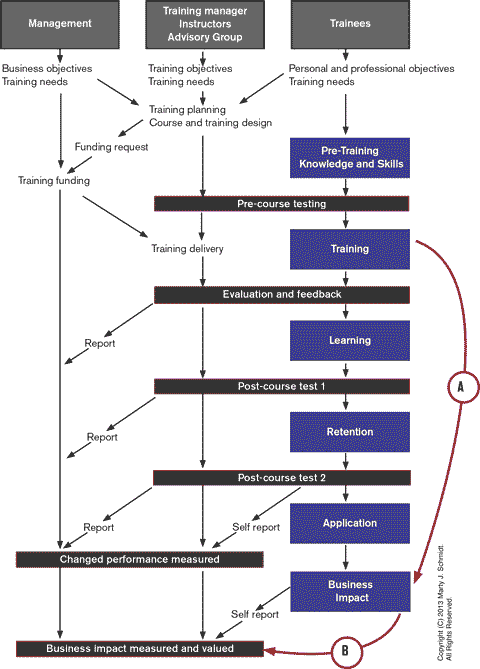Return on Investment for Training
How to Measure Professional Training Value and ROI Returns in Seven Steps
Business Encyclopedia ISBN 978-1-929500-10-9 © 2022 Solution Matrix Ltd All Rights Reserved
Measuring the cost of professional training is straightforward and easy. However, companies that provide employee training must also measure training value—personal value trainees and business value to the firm. Measuring training value is also straightforward but more of a challenge.
Can You Measure Training ROI?
The value of professional training and its return on investment are notoriously difficult to measure.Many business people discover just how difficult when they receive an imperative such as this:
"Show management in believable terms that training has a good return on investment. Or, face a lower training budget!"
Business professionals know that marching orders of that kind are especially likely in these cases:
- The organization moves to zero-base budgeting.
- Mergers or acquisitions are underway.
- A new CFO comes on board.
- Working capital is scarce.
The "investment," or cost side of training is usually easy to find. That is because Training and HR Managers probably have already recorded data on:
- Numbers of people trained.
- The number certified.
- Instructor utilization rates.
- Backfill costs while trainees train.
- Cost per course.
- Training provider costs.
Where is the Hard Evidence for Training Returns?
The challenge in most cases, however, is getting hard evidence for training returns or training value. On the one hand, training managers typically keep trainee course evaluation forms showing that most rate their training as “good” or “excellent.” Most also say it “probably will” help them in their jobs.
Such evidence is, at best, very weak proof that employee training has value. It does not support justification or return on investment metrics. Training managers need more compelling proof of training value to support training budget requests. They ask: How do you measure training value?
- The good news is that managers can indeed measure training value, objectively, quantitatively, and credibly. And these metrics measure value to the organization and value to the trainees. The program for doing so, below, works well in private industry, government, and non-profit groups.
- There is some other-than-good news, however. Putting effective training measurement in place takes time and effort. Measuring the business value of training requires serious planning, communication, and teamwork.
Who is Responsible for Producing Training ROI Figures?
Guidance below addresses a "Training Manager," but it also applies to anyone else responsible for measuring or improving training value. This may include managers, instructors, outside consultants, human resources professionals, and others.
And, for those who must produce a business case to support training requests, note especially that the seven steps below are relevant for most approaches to case building. They apply especially, however, with the case building approach in the ebook Business Case Essentials.
Contents - How to Measure the Value of Training and Training ROI
- Measuring Training ROI.
- Step 1: Recruit, develop, and rely on a training advisory team.
- Step 2: Link training ROI to existing job performance measures.
- Step 3: Measure Level 1: Trainee response to the training.
- Step 4: Measure Level 2: Learning and retention.
- Step 5: Measure Levels 3 and 4: Response to the training.
- Step 6: Measure all the training costs.
- Step 7: Deliver the full training report card.
Related Topics
- For complete coverage of the ROI metric, see Return on Investment.
- For a comprehensive introduction to financial metrics, see Financial Metrics.
Measuring Training Value Step 1
Recruit, Develop, and Rely on a Training Advisory Team

The best candidates for the training advisory team are those who write the trainees performance reviews—the trainee managers.
Real Training ROI is a Team Effort
- Who best knows individual employee training needs?
- Who is in the best position to see post-training benefits on the job?
Answers to both questions are likely to be: The employee's own managers.
These are the people who supervise their work and write their reviews. In launching a training metrics program, the training manager should first recruit 5-15 of these managers for a Training Advisory Team.
What's the Advisory Team Must Do
This team can be effective if two conditions apply:
- Firstly, the team must meet regularly, at least monthly
- Secondly, the team must do more than simply give unstructured advice.
This group can be crucial for establishing the credibility of training “return” metrics. Ideally, group members receive the following assignments:
- Identify and prioritize training needs.
- Evaluate specific training proposals and requests.
- Define training objectives in measurable terms. And, link training objectives to:
- Objectives for the business.
- Personal objectives for participants.
- Provide on-the-spot reports of improvements in productivity, quality of work, employee morale, and turnover rate.
- Ensure that employees complete post-training assessment.
These managers know the individual trainees, their on-the-job-needs, and their day-to-day performance. As a result, they bring authority and credibility to training metrics that the training manager working alone cannot achieve easily.
Recruiting and Getting the Most From the Advisory Team
Training Advisory Team members must know from the outset that the team has work to do. Even if it only meets monthly, there will be pre-meeting homework: identifying training needs and administering post-training evaluation. They may also assist with pre-course preparation, distributing pre-course assignments, and making sure trainees complete them, for instance. And they may discuss training issues with the training manager or training provider often as the training days approach.
What's In It For Them?
“Why,” some might ask, “would very busy managers who have little time to spare, commit to one more job such as the Training Advisory Group?" What’s in it for them? Here are several answers:
- Firstly, they will prepare more easily for tasks that most managers find burdensome:
- Writing their employees’ performance reviews.
- Providing career development guidance and counseling for employees.
- Responding to training requests from inside their organization.
- Justifying their training budget requests.
- Secondly, they will benefit from group performance improvements they can measure and report. They will be able to show in concrete terms, better productivity and work quality, and fewer problems.
The value of this ability should be self-evident, especially for managers thinking of their budget requests and their performance reviews.
The Advisory Team Can Spread the Sense of Ownership
Is training ROI the sole responsibility of the training manager?
When training ROI improves, should all the credit go to the training manager?
Training managers have nothing to lose and much to gain by answering No! to such questions.
They will maximize the accuracy, credibility, and practical value of training metrics if everyone understands that the entire Training Advisory Group owns training measurement. And, when training metrics improve, credit should also extend to individual trainees, technical specialists, content contributors, and other managers.
The training manager should ensure, as well, that Group members know they are a formally established body—not just an informal group who gather for discussion. To underscore this difference, the training manager can do the following.
- Hold regular meetings (usually monthly).
- Prepare and distribute meeting agendas, with individual team member names.
- Ensure that reports and guidance to senior leaders identify team members.
Measuring Training Value Step 2
Link Training ROI to Job Performance Measures

Many firms already have workplace performance metrics in place.
When You Have Good Metrics In Place, Use Them!
Training ROI metrics should recognize the same areas important to metrics systems already in place. Some groups, for instance, already use a performance management system such as, Kaplan and Norton’s Balanced Scorecard system. Where the Balanced Scorecard is present, training metrics should use Balanced Scorecard terms, such as (1) financial metrics, (2) internal business process metrics, (3) customer metrics, (4) learning metrics, and (5) growth metrics. When another system is in place, of course, training ROI measures should use terms from that system's scoring system.
Join Forces with Human Resources
In some organizations, the HR Manager and training manager are different people. Here, it makes perfect sense for the HR and training manager work together and agree on training metrics that link to existing performance metrics. Ideally, they will use the same metrics for assessing individual performance, return on training, and the business impact of training (Step 6, below).
Practical Reality: Not All Metrics Are Equal
Metrics Development: Should you Lead or Follow?
Balanced Scorecard and other well-known performance metrics systems serve very effectively in some places, but in other places, they serve very poorly. The same is true of systems developed in-house. Putting training metrics into an ineffective metrics system has little value or meaning. In such cases, the training manager can provide real value to HR and the whole group by developing training metrics that lead the move to better performance measures.
Ask the Hard Question: Do Current Metrics Work?
Before joining the existing metrics system, the training manager should ask some hard questions.
Firstly, Is the current performance measurement system:
- Understood throughout the organization?
- Used throughout the organization?
- A central focus in:
- Setting high-level business objectives?
- Decision support?
- Performance reviews?
Secondly, does the current performance measurement system:
- Define links between high-level objectives on the one hand, and individual or low-level processes and activities on the other?
- Describe in practical terms what individuals need to do to receive strong performance reviews and promotions?
- Shape behavior to improve high-level company or group performance?
- Identify problems that call for proactive intervention?
A solid “No” to any of these questions is a signal that training ROI and other training metrics must go beyond the current measurement system to have meaning.
Measuring Training Value Step 3
Measure Level 1. Response to the Training

Employees may train through traditional classroom training, on-the-job coaching, one-on-one tutorials, or with online lessons. All can be costly, and all consume significant time for individuals. Measures of training value and training ROI can confirm that training expenses either are or are not justified.
Measure Training at Four Levels
Effective training brings several kinds of returns. Some are important to the group, and some are important to the trainee. Ideally, training measurement captures both kinds of returns.
Most training managers are familiar with Donald Kirkpatrick’s four levels of training evaluation.1 And, most are comfortable basing a training measurement program on Kirkpatrick's system. The system distinguishes four levels of training measurement:
- The learner’s response (reaction) to training
- Learning and retention
- Changed behavior (application)
- Business impact
Measure Level 1: What Can Trainees Tell Us?
Kirkpatrick’s first level is the learner’s response to training. Here is where many training managers squander a golden opportunity by using tepid end-of-course rating forms. Many refer to these—unkindly but accurately—as "smile sheets."
Do Not Settle for the Smile Sheet
Smile sheets simply ask participants to score such things as course value, instructor performance, and quality of course material and handouts.
Such ratings from an entire class are helpful when participants overwhelmingly agree that any of the above were very good or very bad. They also help show trainee's general feelings about the training. However, they typically say very little that is actionable for the training manager.
Instead, trainee course evaluation should be serious business. There is an opportunity here to gather information from trainees that only they can give us. They can tell us their view of training value for the group and themselves. They can also tell us in concrete terms what should change to improve training for future trainees.
Ask Specific Questions
For each main content areas, the training manager can ask specific questions about:
On the Job Impact and Benefits.
- How trainees expect to use what they learn on the job.
- Where the training contributes to group performance, productivity, or quality of work.
- What they think the training is worth in monetary terms.
Personal and Professional Value.
- Where and how the training contributes to their personal and professional goals.
- Which new knowledge or skills from training are most valuable.
- Which aspects of the training are least valuable.
Course Improvement. How Does the Trainee Evaluate the…
- Distribution of time on different content or skill areas.
- Course length.
- The balance between lecture and discussion.
- The balance between content and practical exercises.
- Design and facilitation of practical exercises.
- The value of pre-course work in preparing for training.
- Instructor’s preparation and delivery in each course area or module.
- Connections between course objectives, course content, and on the job needs.
- The relationship between this course and other training.
- What else should be in the course? What should be omitted
Write the Post-Course Evaluation Form
With the above possibilities in mind, the training manager can write a draft post-course evaluation form for the Advisory Group to review and adjust. The purpose is to create a single set of questions for use with all course offerings. Responses on these forms may not contribute directly to a financial ROI metric, but they are a unique and important part of the overall training metrics plan. They are useful for:
- Knowing where to look for on-the-job performance changes and business impact.
- Providing input for career counseling and performance reviews.
- Helping other employees choose training offerings.
- Planning the best use of training resources—when combined with the three other measurement levels below.
Practical Reality: Course Evaluation Should be Serious Business
Evaluation form: A Ticket to Freedom?
Instructors reinforce the low status of course evaluations when they treat them as an afterthought—something to complete quickly in the last five minutes of the session. In such cases, trainees see the evaluation form simply as a ticket to freedom—the last thing to do before getting out of class.
Post-course Evaluation "Do's" and "Don’ts"
post-course evaluations have real value only if managers and trainees alike expect them to have value. Here are some "Dos" and "Don'ts" on steps the training manager can take to help set that expectation.
Do insist on Consistency in Course Evaluation Forms and Ratings.
- Insofar as possible, use the same questions and forms from course to course.
- Be consistent with rating scales. If high numbers are “good” (or the reverse) stay with that system.
Don’t Evaluate at the End of a Course Agenda.
Instead, evaluate an hour or two before course finish, at least. And, provide the evaluation exercise a time slot of its own in the agenda. Better still, if it's a multi-day course, evaluate early in the afternoon of the final day. As a result, there should be no incentive to hurry through the forms.
Do Require Participants to Identify Themselves on Evaluation Forms.
Should participant evaluation responses be anonymous?
Some managers responsible for training believe that participants will respond more fully and more truthfully when they respond anonymously. Not surprisingly, there is a substantial body of academic research designed to test that belief. And, certainly, some results of that research support that belief--at least when the response calls for self-disclosure about personal behavior.
Nevertheless, there are other and better reasons for insisting that course evaluations not be anonymous. Having participants identify themselves:
- Is the only way the evaluation can contribute to employee performance reviews or counseling.
- Allows instructors to follow up questions or comments.
- Enables instructors to connect comments with the person's questions and contributions in class.
- Because when people know they are personally responsible for feedback, they generally put more care and thought into the feedback.
Don’t Delay Circulating post-course Test Results.
Don't allow many days to pass after the course before circulating summary results to participants and senior leaders.
Do See That Instructors Exercise Discipline.
Do see that all instructors exercise the same course evaluation discipline, whether they are your staff or outside trainers.
Measuring Training Value Step 4
Measure Level 2. Learning and Retention

It is very hard to estimate training learning and retention, without post-course testing.
Do You Really Need Pre- and Post-Course Testing?
Anyone who teaches in the school systems or university knows that creating and evaluating exams is an important but labor-intensive task for the instructor. Nevertheless, the training manager who wants to demonstrate training ROI, must be able to show concrete links between training and business impact. Exams are key to showing this link.
Proving “demonstrated learning” (Kirkpatrick’s level 2) means testing trainees with a content exam before and after training. Without pre- and post-course testing, it is very hard to credit specific learning to the training.
Proven learning that is not retained, moreover, cannot contribute to business impact. And, note that immediate retention after class is not likely to be the same as long-term retention. A post-training exam in the last hours of a training day will produce higher scores than the same exam given a week or a month later. The latter, however, measures long-term retention.
Testing Three Times
The training manager and advisory group can make it a matter of training policy, to test trainees three times for each course offering:
- Pre-course testing, at least one week before the first training day.
- Post-course exam, on the day after the final training day. Scores from this are compared to pre-training scores to measure learning.
- Second post-course exam, completed in the fifth week after the final training. These scores help measure long-term retention.
Practical Reality: The Hidden Value of Testing
Testing is More Than Measurement
Producing a credible training ROI figure usually requires a three-phase testing approach of this kind. Training demonstrates business value only when learning and retention metrics link to behavior changes and business impact. It is very hard to estimate learning and retention reliably, and credibly, without testing in this way.
Pre-Course Testing: An Example
Solution Matrix Ltd. delivers course offerings each year on subjects such as “The Basic Language of Business,” and “Building the Business Case.” Pre-course tests probe the areas around each training objective, such as this one:
Objective: To understand and explain which items in the Income statement and Balance sheet can be important to the business case builder, and why.
If the trainees will use business case skills for internal decision support and planning, we test them on the financial goals and the financial condition of their organization. And, when trainees are salespeople who must understand their customer’s business, tests focus on customer situations and goals. Specific questions around this objective might include, for instance:
- What was operating margin (or operating profit) last year?
- Is this considered good? Is it acceptable? Or, is it a high priority target for improvement?
Using Pre-Test Results
Answers on the pre-test are compared to post-test results to measure learning and retention. Simply taking the pre-course test, however, can also:
- Help change a trainee’s attitude from “I don’t need this course” to something more positive. Pre-course testing, in other words, helps trainees see what they already know and what they do not know. The pre-course test may be humbling, but it should also motivate. It should not be devastating or demoralizing.
- Set expectations accurately for what they will cover and learn in the course. No one should be surprised or disappointed by what they find in the course itself.
- Help the instructor identify areas that will need more emphasis or less emphasis in the course. If the pre-course test is complete before training day, there is time to plan course adjustments.
First Post-Course Test, for Learning and Reinforcement
Ideally the first post-course test should come no more than day after training, while the course experience is still fresh in mind. This test measures learning, but is also part of the learning process. Trainees who take a comprehensive post-course exam are also reviewing and reinforcing course content. Research studies show repeatedly that trainees who must recall and explain what they have just been through in training, will generally score better than those who don’t do this, when tested weeks later.
Second Post-Course Test for Retention and More
Training has business value back on the job only if trainees retain and apply what they have learned. A third test, four or five weeks after training, will measure of long-term retention. This test, however, can also help show where trainees are applying learning.
The retention test will probe the same knowledge and skills examined in the first two tests. By now, however, trainees have had the chance to use what they learned on the job. Their managers will also assess performance changes (next step, below).
In any case, trainees should be able to answer in concrete terms specifically:
- How, where, and by how much their productivity or efficiency has improved.
- What can they now do in less time? (Complete design jobs, respond to customer questions, prepare analyses or reports, or set up a production machine, for instance.)
- By how much has efficiency or productivity improved? (In terms of cost, production units, or time required, for example.)
- Where has the training helped improve the quality of their work?
- What can they now do better than before training? Deliver better customer service? Sell more effectively? Improve product quality?
- By how much has quality improved? (Measured in tangible terms, such as customer satisfaction scores, more sales closed, or lower cost of scrap or spoilage.)
- What are they doing now that they could not do before? (In terms of new job skills, new activities, new objectives, or new responsibilities, for instance.)
Measuring Training Value Step 5
Measure Levels 3 and 4. Behavior Changes and Business Impacts

Training ROI comes into view when behavior on the job changes and the employer measures the business impact of those changes.
Bring in the Training Advisory Team
For the company focusing on training ROI, the “R” lives at Kirkpatrick’s levels 3 and 4: measuring behavior changes and business impact. This is where the “training advisory group” (Step 1) can play a vital role in getting training ROI that means something.
Training has value to the group only when it leads to changes in behavior that help meet business objectives. Trainee's managers should be able to measure skill and performance levels before and after training, evaluating:
- Percent of participants applying new learning on the job (the application rate).
- Tangible improvements in productivity or efficiency.
- Tangible improvements in quality of work.
- New abilities or skills after training.
- The link between changed behaviors and business objectives.
The last bullet above is key to assigning financial value to training results.
Consider a company, for example, keenly interested in improving customer satisfaction. Toward this end, they launch a training program for their customer service telephone support agents. These people are the primary interface between customers and the company.
Managers will look for tangible results from training, such as better phone manners, faster and more accurate responses to customer questions, and improvements in dispute resolution. These changes are evidence of level 3 improvements, behaviors.
The next level, Level 4 measurement, asks: “What is this worth in terms of ‘Returns’ for the ROI equation?”
Reaching Business Objectives Has Value
For this example, the training manager and senior management must agree first on the financial value of reaching the company’s customer satisfaction goal. The goal must have a target level, and progress towards the target must be measurable in tangible terms such as customer satisfaction survey scores, numbers of complaints, or churn rate (percentage of customers who drop service every month).
Reaching the goal should bring a number of changes that clearly have financial value, such as a larger customer base, lower cost of sales, or lower cost of customer service delivery. It may also lead to lower customer churn rates. If they can estimate a total financial value for these consequences, they are well on the way to agreeing on “R” for the training.
Practical Reality: What’s it Worth in Real Money?
Make the Links
Individual trainees may be able to report what the training is worth to them personally and professionally, in several ways. They may see better job opportunities, promotion, professional recognition, higher pay, or job satisfaction, for instance.
That value is part of the total training “returns,” and should appear on the complete Training Report Card (Step 7, below). It should also appear in job performance reviews and career counseling plans for individuals.
But what about the financial value to the organization? How do we get an “R” in dollars ( or other currency) to put into a real financial ROI metric? Establishing the training R in financial terms begins by connecting the links in the chain we have been following:
- Pre-training skills and knowledge (Pre-course test).
- Learning from the course (First post-course test).
- Retention (Second post-course test).
- Application and changed behavior (Second Post-course test and manager confirmation).
- Business impact (Contributions to important business objectives, attributable to the training).
Follow the Chain
This chain is path “A” in Figure 1 (below), which summarizes the communication, measurement, analysis, and teamwork in a successful training measurement program.
- Reaching important business objectives has financial value for the organization.
- Training that contributes towards reaching those objectives deserves some of the credit, in financial terms.

Figure 1. Measuring the business value of training requires communication, measurement, analysis, and teamwork from everyone involved. The credibility of the value figure depends most on (A), the links between training and business impact, and (B) how business impact from training is measured and valued.
The only questions remaining are: What is the value of reaching business objectives? And how much of the credit for reaching the objective should go to the training?
Returns Come From Meeting Business Objectives
Profit-making company have one ultimate objective: increasing owner value. Companies do this by earning profits which are then paid directly to shareholders as dividends or kept as retained earnings. nonprofit, government, military, educational, and charitable organizations, similarly, have a single overriding mission.
Supporting the top-level objective are important strategic objectives. These describe what the organization must do to survive and grow in the eyes of senior leaders. They can defined and measure some of these in financial terms, such as increased sales revenues. And, they will instead define and measure some in nonfinancial terms, such as improving customer satisfaction or improving the quality of service delivery.
Ask: What's it Worth to Reach Objectives?
In order to estimate the financial value of the training impact, you must first ask “What is it worth, in real money, to reach the important business objective? There is no universal or easy method for finding an acceptable answer for all objectives, but the question is reasonable and important.
Putting a value on each business objective may call for different tactics, such as:
- Estimating increased sales and profits.
- The cost of not meeting the objective.
- The cost of meeting the objective by another means
- Reduction in costly problems or errors
- Simply the value management would “pay” to achieve the objective
Example Objective: Customer Satisfaction
Continuing an example, consider again the company intent on improving customer satisfaction. One initiative targeting this objective is a training program for customer service center Call Center operators. Better customer telephone support by itself probably will not take the company all the way to its customer satisfaction objectives, but it can contribute to reaching the goal.
Assume for this example that management agrees that reaching targets for customer satisfaction objectives has a value of $10 Million per year. Now, the training manager and senior management must also agree on the on the percentage of the total benefits figure they should credit to better customer service from training. If better customer service is essential for reaching the goal, training should receive a larger percentage. If better customer service is just one of many customer satisfaction initiatives, then it may receive a smaller percentage.
Remember that a small percentage of a very large number is still a large number. If leaders agrees that reaching customer satisfaction objectives is worth $10 Million per year, and even if they only allot 10% of the "credit" for that to a training course, they are still making a statement that course value to the company is $1,000,000. That figure is no doubt many, many times higher than the cost of training.
To reach the financial “R” for training ROI, you will then have to ask: What percentage of the objective’s value should be credited to the training? You will have to decide whether training is essential to reaching the objective, or instead one of many contributing factors.
Measuring Training Value Step 6
Measure All Training Costs

Training managers can develop the measure "Cost per successful trainee," as part of the overall return on investment calculation.
Find the Cost Per Successful Participant
With “R” now in hand, the training manager can move on to the "I" in ROI, the training investment costs. The manager will no doubt already have total costs for the training itself, which will go into the ROI equation as “I.” However, to fully understand the return on training costs, the training manager should also calculate “Cost per successful participant” to show management how training ROI should improve further in the future.
Consider again the Call Center operator training example, where the training manager has two training modes to choose from:
- Traditional classroom instruction, and
- A newer nontraditional e-learning based training program.
The e-learning approach involves more participant interaction, provides learning in small “chunks” over a longer time period, and “refresher” feedback after participants return to the job.
Example: Comparing Two Approaches to Training Costs
Assume, however, that the e-learning option is more expensive than the traditional classroom approach, but that the training manager expects e-learning will nonetheless lead to a higher training ROI. There is good evidence that for some subject areas, the non traditional approach leads higher retention rates and higher application rates, because it will deliver a lower cost per successful participant.
Using measured retention and application rates from prior offerings, and considering now the numbers of successful training participants, there is indeed a cost advantage to the nontraditional approach. Table 1 below shows what that means:
| Traditional Classroom | Nontraditional Approach | |
| Cost / participant | $1,500 | $2,000 |
| Number trained | 100 | 100 |
| Retention rate | 50% of participants | 80% of participants |
| Application rate | 50% of retention | 70% of retention |
| Successful participants | 25 | 56 |
| Cost per successful participant | $7,500 | $3,571 |
Successful participants, in other words, are those who demonstrate acceptable retention and application (changed performance) after the training. Only these participants will contribute to the “R” in training ROI. The cost per successful participant metric highlights the importance of achieving and measuring retention and application, if you are aiming for a high training ROI.
Practical Reality: The Hidden Costs of Training
Whose Costs Are We Counting?
There are two ways to increase training ROI: (1) Increase the returns “R” or (2) decrease the investment costs, “I.” If you are the training manager, it may be tempting to focus the cost analysis on the funds that actually flow into and out of your training budget.
A training ROI describes “returns” to the entire organization, however, and these should be compared to training costs for the entire organization. Otherwise, ROI to the organization is overstated. Before giving management a training ROI figure—for a single course or for the year’s training program—the training manager will want to discuss with management and with the Training advisory group, just which costs do belong in the ROI cost figure and which do not. There is room for some differences of opinion and subjective judgments here, and you will want to be sure that everyone involved understands which costs are included and which are not. Some cost issues to consider:
Fixed Training Costs
It is a small and rare organization that has no fixed training costs. These are the costs the organization will pay regardless of how many courses are offered and how many people trained (within limits of course). Fixed training costs for the year may include goods and services dedicated exclusively to training:
- Professional training staff: Salaries and overhead for the training manager, instructors, course developers, training administrators, and so on. Do not leave out the CLO if there is one (Chief Learning Officer).
- Facilities and equipment for training (Purchase, lease, and maintenance of classrooms, breakout rooms, projectors, whiteboards, supplies, etc.).
- Training marketing programs, if the year’s offerings are marketed together.
- Training "startup" costs (e.g., for pilot offerings) and course development costs.
Variable Training Costs
The training investment may include variable costs that depend on the number and kinds of courses or other offerings:
- Course development costs (including pilot testing and course revision).
- Instructor costs, either internal or external, if the instructor is not on the training staff.
- Course purchase or offering fee, if the course is provided by an outside contractor or supplier on a flat fee basis.
- Course customization and preparation of materials by outside suppliers.
- Facilities and/or equipment rental for the course.
- Outside instructor travel and living expenses.
Finally, there may be variable costs that depend on the number of trainees, such as:
- Registration fee per participant (for courses supplied by outside provider).
- Printing of course materials.
- Participant travel and living expenses (for off-site training).
Which of these costs belong in the “training ROI” calculation? If you want to describe training ROI for the training program (or training organization), then, clearly, fixed and variable costs both belong in the equation. On the other hand, if the intent is to describe incremental training ROI for one specific course, and addition of the course would not change fixed costs, only the variable costs need be counted.
Opportunity Costs and Other Hidden Costs
Training usually takes people away from the job for at least the length of the course, or longer if travel is involved. A two-day course in another city can easily keep the trainee off the job for four days, for instance. Trainees still receive salaries and benefits while they are traveling and training and—some say—they aren’t doing productive work that they receive pay for. Training managers are often uncertain whether or not to count the cost of this “lost labor,” or “opportunity cost” in the training ROI cost calculation.
The appropriate approach depends on whether or not the organization incurs a real cost because of time away from the job for training. Management should ask:
- Do projects or other work assignments reach completion later because the trainee was away from the job, on training?
- Does the trainee’s overall productivity for the month decrease because of the training event?
- Does the organization have to hire temporary help to cover them while away for training?
If the answer is “Yes” to any of the above, then the cost of lost labor, or opportunity cost belongs the total training cost calculation.
For many professionals, however, employers expect them to stay productive and complete work assignments on time despite being off the job for training. Many stay in touch during breaks or evenings with laptop computers, keep phone appointments, and spend after class hours making sure nothing on the job is neglected. Whether or not that is healthy for the individual is another question, but one reality for many is that time away from the workplace is not time off the job. And that means no "opportunity cost" in the training cost sum.
Measuring Training Value Step 7
Deliver the Full Training Report Card

Training managers will report several measures of training value besides training ROI.
The problem with any single training metric, such as “Training ROI,” is that it does not communicate everything important about the “returns” from training. For this reason, training managers will want to report several kinds of “return” measures. They will in fact measure, record and report summaries of most of the testing elements from Figure 1:
- Course evaluations and feedback: The trainee's views of the value of the training, and where they can use it on the job.
- Post-course test 1 results: A direct measure of what, specifically, they learned in the course (compared to pre-course testing results).
- Post-course test 2 results: Measured retention, along with trainee self reports on where trainees expect to apply learning and achieve business impact.
- Measures of performance confirmed by trainee management.
- Measures and values of business impacts.
- Cost per successful participant.
- Training ROI per course
- Training ROI for the training program.
And, if management uses a comprehensive system for performance metrics, such as the Balanced Scorecard system, the training managers and HR managers will want to be sure they provide training measures in terms of those metrics.
Calculating Training ROI
At the end of the day, however, leaders will want to see the ROI metric itself. There are many different “ROI” calculations in use, but when the subject is “Training return on investment,” the clearest and most direct approach is probably “Simple ROI,” that is, incremental return over training cost:
Training ROI = (Total returns – Training cost ) / Training cost
With an ROI figure, the training manager can also discuss and compare the two avenues for improving ROI: reducing total costs, and increasing total returns (by improving retention and application rates, for instance). That is a discussion that leaders should appreciate because it is all about business objectives.
When the training manager must produce a business case to support training requests, the seven steps above, training value measurement, and the ROI result, have relevance for most approaches to business case building. They are especially applicable, however, with the case structure and content in Business Case Essentials (www.business-case-analysis.com/busfse-essentials.html).
Footnote:
1. Donald Kirkpatrick, former President of American Society for Training and Development (ASTD), began publishing his training and training measurement ideas in 1959. His final book on the subject was first published in 1994. and is now in its third edition.
Kirkpatrick, D. L. and Kirkpatrick, J.D. Evaluating Training Programs, 3rd Edition. Oakland, California, Berrett-Koehler Publishers, 2009

